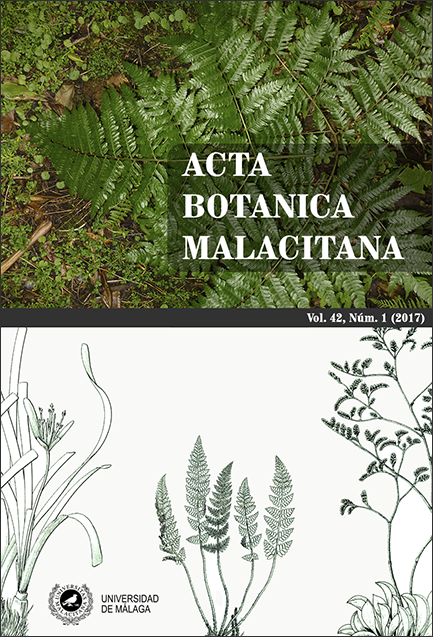Tres especies nuevas de Hymenophyllum (Hymenophyllaceae; Pteridophyta) para Costa Rica y Colombia.
DOI:
https://doi.org/10.24310/abm.v42i1.3009Abstract
En este artículo tres especies nuevas de Hymenophyllum Sm. son descritas e ilustradas para Costa Rica y Colombia: H. densipilosum A. Rojas, H. hastatum A. Rojas e H. multicristatum A. Rojas. Todas las especies aquí descritas están relacionadas a H. plumosum Kaulf. por la lámina densamente pelosa en ambas superficies, los tricomas estrellados y la presencia de alas o crestas en la superficie dorsal de las venas. La primera especie difiere de H. plumosum por lámina 1-pinnada-bipinnatífida a 2-pinnada-pinnatisecta, relativamente más ancha, la lámina más densamente pilosa, los pelos de haz blanquecinos a dorados y adpresos y distribuida a mayor elevación. La segunda especie se diferencia de H. plumosum por lámina menos densamente pelosa, pinnas equiláteras y hastadas con dos grandes lóbulos basales y alas del lado dorsal de la lámina más anchas. La tercera especie se distingue de H. plumosum porque presenta lámina oblanceolada, pinnas más marcadamente incisas, haz de la lámina menos densamente peloso y venas dorsalmente con (2-) 4-5 alas paralelas y seccionadas en crestas.
Downloads
Metrics
References
Dubuisson, J.-Y. (1997). rbcL sequences: A promising tool for the molecular systematics of the fern genus Trichomanes (Hymenophyllaceae). Molec. Phylogenet. Evol. 8: 128–137.
Ebihara, A., Hennequin, S., Iwatsuki, K., Bostock, P.D., Matsumoto, S., Jaman, R., Dubuisson, J.-Y. & Ito, M. (2004). Polyphyletic origin of Microtrichomanes (Prantl) Copel. (Hymenophyllaceae), with a revision of the species assigned to the genus. Taxon 53: 935–948.
Ebihara, A., Dubuisson, J.-Y., Iwatsuki, K., Hennequin, S. & Ito, M. (2006). A Taxonomic revision of Hymenophyllaceae. Blumea 51: 221–280.
Gómez, L.D. & Arbeláez, A.L. (2009). Flora de Nicaragua. Tomo IV: helechos. Missouri Botanical Garden, St. Louis, Missouri, USA. 348 p.
Mickel, J.T. & Smith, A.R. (2004). The Pteridophytes of Mexico. Mem. New York Bot. Gard. 88: 1–1029.
Moran, R.C. & Riba, R. (eds.) (1995). Flora Mesoamericana. Vol.1. Psilotaceae a Salviniaceae. Universidad Nacional Autónoma de México. 470 p.
Murillo, MT., Murillo, J., León, A. & Triana, L.A. (2008). Los Pteridófitos de Colombia. Arfo. Bogotá, DC. 533 p.
Pryer, K.M., Smith, A.R., Hunt, J.S. & Dubuisson, J.-Y. (2001). rbcL data reveal two monophyletic groups of filmy ferns (Filicopsida: Hymenophyllaceae). Amer. J. Bot. 88: 1118–1130.
Schuettpelz, E., Pryer, K.M. & Buckley, T. (2006). Reconciling extreme branch length differences: decoupling time and rate through the evolutionary history of filmy ferns. Syst. Biol. 55 (3): 485–502.
Tryon, R.M. & Stolze, R.G. (1989). Pteridophyta of Peru: part 1. 1. Ophioglossaceae 12. Cyatheaceae. Fieldiana Bot. n.s., 20. 1–145.
Downloads
Published
How to Cite
Issue
Section
License
Those authors who publish in this journal accept the following terms:
a. The authors will retain their copyrights and guarantee the journal the right of first publication of their work, which will be simultaneously subject to the Creative Commons Attribution-Non-commercial 4.0 license whose full text can be found at <http: // creative commons .org / licenses / by-nc / 4.0> that allows third parties to share the work as long as its author and its first publication are indicated, and as long as it is not for commercial purposes.
b. Authors may adopt other non-exclusive licensing agreements for the distribution of the version of the published paper (e.g., deposit it in an institutional telematic file or publish it in a monographic volume) provided that the initial publication in this journal be indicated.
c. Authors are allowed and recommended to disseminate their work through the Internet (e.g., in institutional telematic archives or on their websites) before and during the submission process, which can produce interesting exchanges and increase citations of the published work. (See The effect of open access)







1.png)
